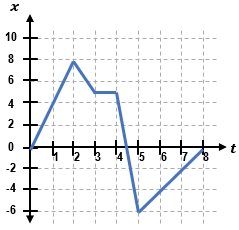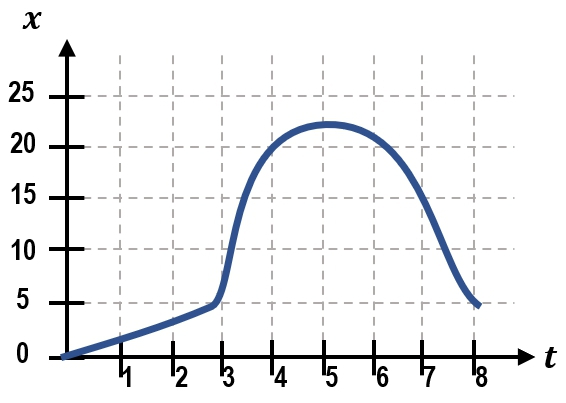Hey, guys. So sometimes in your problems, you're going to be given graphs instead of numbers. In this video, we're going to talk about position-time graphs and how we use them to calculate things like velocity. Let's check it out. Now, guys, the basic idea is that a position-time graph just shows you an object's position on the y-axis, so right here, versus time on the x-axis over here. That might be kind of confusing because we're going to use position which is given by the variable x, but it's actually on the y-axis or the vertical axis. So don't let that confuse you. Make sure you understand that. Position-time graphs help us sort of understand or visualize the motion of an object much more simply. For example, let's say you were to walk 6 meters forward in 3 seconds, you stop, and then you run 6 meters back. You'd have to basically draw out all the points a, b, c, d, label all the parts and things like that. What we can do is we can actually represent it much more simply on this graph here. For example, if you were to go 6 meters forward in 3 seconds on the position-time graph, you're going from 0 all the way up to 6 in 3 seconds. So you basically just go up and over 6 and then 3. So you're going to end up right over here, and then we just connect where you started from which is at the origin with just a straight line like this.
Now finally, or the second part is that you could just stop for one second. So basically from b to c, you actually haven't moved anywhere. It's hard to see on the diagram what's actually happening. But from 3 to 4, if you're not moving anywhere, then your position just stays the same. You start at 6 and then you stay at 6. So it means we're just going to connect these points with a straight line. And then finally, you're going to go from 4 seconds all the way back to 5. So that just means from 4 to 5 over here, you're going all the way back to where you started from. So then we can label the pieces here a, b, c, and d. This graph here just represents everything you did on this diagram, but all kind of just in one place without having to draw all these little things here, and it kind of looks weird.
What the position-time graphs also do is, we can calculate the velocity directly from the graph. For example, we know that the equation is delta x over delta t. So for instance, if I look at the interval from a to b, this little line here, I can actually break this up into a triangle and I can take a look at the legs of the triangle. The vertical piece over here actually represents my change in position because that's on the vertical axis. So you can think about this as the rise of the graph. And the horizontal leg is delta t. That's the change in time, and you can think about this as the run of the graph. So that means that my delta x over delta t on this graph is really just the rise over the run, and that's a phrase we've seen before. It's the slope. So, guys, the velocity is the slope of the position graph, and there are a couple of things you want. When you have upward slopes like we did from a to b, that just means that you're moving forward and that makes sense because that represents this motion here when we move forward. If you have a horizontal slope, basically, a flat one like this, then that means that you've stopped because your position isn't changing. And then, finally, a downward slope like this from c to d is when you're moving backwards like we were moving in that last section over here.
Guys, that's all you need to know. Basically, there's just one simple equation we're looking at. It's a bunch of slopes, calculating some slopes. So let's just get to an example. So we've got this position-time graph here. I'm going to calculate the typical velocities for these parts. Let's check it out. So, we've got to go from 0 to 2 seconds. All you have to do is just go from 0 to 2 and we just need to identify those points on the graph. So at 0, I'm over here and at 2, I'm over here and I'm just going to calculate the slope of this line. So let's go ahead and do that. My average velocity is just delta x over delta t. So on the graph, I'm going to end at 10, but I'm going to start at negative 10. So that means that the delta x is my final position which is 10 minus my initial position which is negative 10. So this is my initial, that's my final, and my delta x is just equal to 20. So I've got 20 and then the time is just from 0 to 2 seconds, so that's just 2. So that means just to get a positive 10 meters per second for the velocity here.
Alright. Let's move on. So the second part is going to be from t equals 2 to t equals 4. Same thing. We're just going to go from t equals 2 to t equals 4. The line's already drawn for us. Now we just have to calculate the slope. So my average velocity here is just going to be delta x over delta t. So what's the rise? Well, if you notice here, we've got a flat line. So that means that the rise is 0. You haven't moved anywhere. You started off at 10 and you ended up at 10. So you haven't actually moved anywhere. There's no rise. So that means that 0 over whatever the time is, in this case, delta t equals 2 seconds, doesn't matter because you're still going to end up with a velocity of 0 and that makes sense because 0 meters per second means that you should have a horizontal or a flat slopeibe like this.
And then, you know, when we got 10 meters per second, we actually got an upward slope so it also makes sense. Now, for the last one, t equals 45. So this is just going to be this section right here from t equals 45. So my delta x, my rise is just going to be well, I'm going from 10 and I'm going to en...



